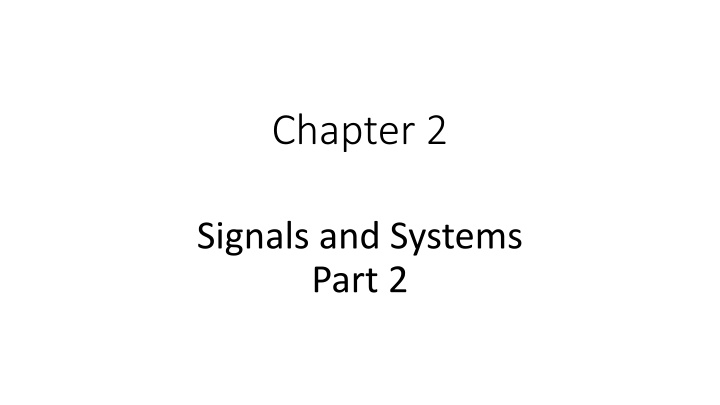
Signals and Systems: Fourier Series, Square Wave Approximations, and Orthogonality
Explore the concepts of Fourier series, square wave approximations, and signal orthogonality in the context of signals and systems. Learn how square waves, trigonometric series, and exponential decay can be represented and analyzed using mathematical approaches. Understand the significance of signals as vectors and their orthogonality properties in signal processing applications.
Download Presentation

Please find below an Image/Link to download the presentation.
The content on the website is provided AS IS for your information and personal use only. It may not be sold, licensed, or shared on other websites without obtaining consent from the author. If you encounter any issues during the download, it is possible that the publisher has removed the file from their server.
You are allowed to download the files provided on this website for personal or commercial use, subject to the condition that they are used lawfully. All files are the property of their respective owners.
The content on the website is provided AS IS for your information and personal use only. It may not be sold, licensed, or shared on other websites without obtaining consent from the author.
E N D
Presentation Transcript
Chapter 2 Signals and Systems Part 2
Review: Fourier Series of Square Wave Square wave with period 2 . Square wave with period 2 is determined by values in [- , ]: Square wave is a 1-bit quantization of cosine: Crystal oscillators for digital circuits convert sinusoidal outputs to square waves using comparator and amplifiers. 3/18/2025 Chapter 2: Signals and Systems 2
Fourier Series of Square Wave (cont.) If n 0, If n = 0, 3/18/2025 Chapter 2: Signals and Systems 3
Fourier Series Coefficients of Square Wave 3/18/2025 Chapter 2: Signals and Systems 4
Trigonometric Series Approximating Square Wave N = 3, N = 9 N = 11, N = 19 3/18/2025 Chapter 2: Signals and Systems 5
Fourier Series of Periodic Exponential Decay The Fourier series representation is The phase is: This calculation was done offline by copying from textbook. Other approaches are MatLab and Mathematica. 3/18/2025 Chapter 2: Signals and Systems 6
Signals as Vectors A signal g(t) defined for a finite number of time variables, can be considered to be a vector of dimension n: The Euclidean norm (or size or magnitude) is (This definition works for complex-valued signals.) The norm is used to measure how far apart are two signals, e.g., to tell how good an estimate is: 3/18/2025 Chapter 2: Signals and Systems 7
Orthogonality If two signals are orthogonal, then by Pythagoras theorem, Thus two signals are orthogonal if and only inner product f g = 0. (In this case the energy of the sum is the sum of the energies.) Recall that: if 3/18/2025 Chapter 2: Signals and Systems 8
Signals as Vectors, 2 For most signal processing applications, the number of samples is much larger than 3, so we cannot easily visualize signals as vectors. When the dimension is infinite, the signal s norm may be infinite. If the signal has finite energy and is said to belong to L2. Gauss determined the orbit of Ceres using only 24 samples and an early version of the FFT. 3/18/2025 Chapter 2: Signals and Systems 9
Signals as Vectors, 3 3/18/2025 Chapter 2: Signals and Systems 10
Component of a Vector along Another Vector 3/18/2025 Chapter 2: Signals and Systems 11
Component of a Vector along Another Vector, 3 3/18/2025 Chapter 2: Signals and Systems 12
Application to Signal Detection 3/18/2025 Chapter 2: Signals and Systems 13
Application to Signal Detection, 2 3/18/2025 Chapter 2: Signals and Systems 14
Parsevals Theorem 3/18/2025 Chapter 2: Signals and Systems 15
Negative Frequencies 3/18/2025 Chapter 2: Signals and Systems 16
